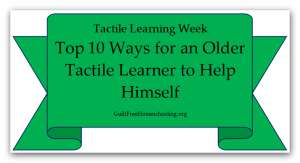 These tips will be helpful to tactile students in middle school, high school, college, or beyond, who need to motivate themselves and control their own learning environment.
These tips will be helpful to tactile students in middle school, high school, college, or beyond, who need to motivate themselves and control their own learning environment.
- Use a chalkboard, whiteboard, etc. to draw out graphs, flow-charts, etc. as a study aid.
- Make your own posters, diagrams, and charts with various materials because it is the act of creating that helps tactile learners learn and understand. A bulletin board, notecards or Post-Its, yarn, and push-pins can transform confusing information into a dynamic chart that you’ll never forget!
- Doodles in the margins are actually a helpful memory key when studying notes for tests. (I remember this… it was on the page with the White Rabbit in the corner…)
- Paint your nails (or paint your sister’s nails) or doodle to help you think through a tough problem or organize your ideas for a project. Do woodworking, crocheting, knitting, etc. while mentally reviewing facts.
- “Executive desk toys” are great for keeping your hands and fingers busy while your brain chews on tough information or reviews test material: stacking magnets, miniature sand gardens, etc.
- Grab a lot of somethings to illustrate a ratio or growth-percentage problem. Manipulatives aren’t just for learning addition.
- Use cardboard and duct tape (or modeling clay, K’nex, Legos, or whatever you have on hand) to build a model of the concept that has left you stumped.
- The act of taking notes (whether or not they are ever used again) helps a tactile learner remember information. Using markers or crayons for taking or recopying notes can give a whole different feel to the writing process, as yet another memory key.
- Use notecards or flashcards with flashcard holders [links below]. Simplest card holder of all: 3×5” sandpaper or textured paper with photo corners on back to hold notecard (textured side faces away from notecard).
- Incorporate learning methods from the other 3 styles to improve your overall learning abilities.
For further help, visit these links:
Learning Styles v. It’s a Syndrome
Tactile Card Holders, Version 1
Tactile Card Holders, Version 2
“Tactile Learning” topic (including all of this “Tactile Learning Week” series)
“Learning Styles” topic
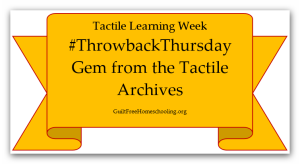
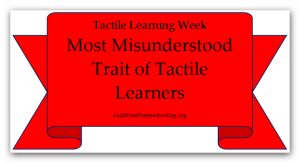
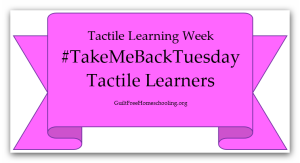
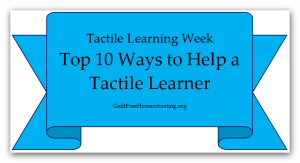
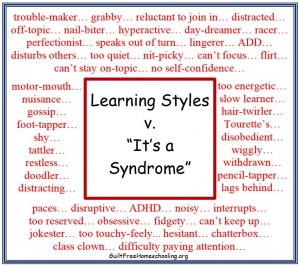



 Guilt-Free Homeschooling is the creation of Carolyn Morrison and her daughter, Jennifer Leonhard. After serious disappointments with public school, Carolyn spent the next 11 years homeschooling her two children, from elementary to high school graduation and college admission. Refusing to force new homeschooling families to re-invent the wheel, Carolyn and Jennifer now share their encouragement, support, tips, and tricks, filling their blog with "all the answers we were looking for as a new-to-homeschooling family" and making this website a valuable resource for parents, not just a daily journal. Guilt-Free Homeschooling -- Equipping Parents for Homeschooling Success!
Guilt-Free Homeschooling is the creation of Carolyn Morrison and her daughter, Jennifer Leonhard. After serious disappointments with public school, Carolyn spent the next 11 years homeschooling her two children, from elementary to high school graduation and college admission. Refusing to force new homeschooling families to re-invent the wheel, Carolyn and Jennifer now share their encouragement, support, tips, and tricks, filling their blog with "all the answers we were looking for as a new-to-homeschooling family" and making this website a valuable resource for parents, not just a daily journal. Guilt-Free Homeschooling -- Equipping Parents for Homeschooling Success!

Recent Comments